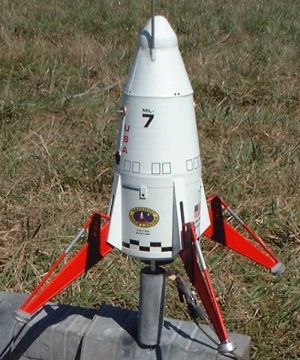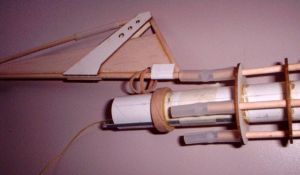| Construction Rating: | starstarstarstarstar_border |
| Flight Rating: | starstarstar_borderstar_borderstar_border |
| Overall Rating: | starstarstarstar_borderstar_border |
| Diameter: | 3.74 inches |
| Length: | 12.40 inches |
| Manufacturer: | Semroc  |
| Skill Level: | 4 |
| Style: | Futuristic/Exotic |
Brief:
For those of you old enough to have either nostalgic memories of the Estes K-43 Mars Lander or at least longed for one, this faithfully reproduced offering by Semroc will bring back some great memories. I'm not quite old enough to have been a part of the 1969 introduction, although I can at least relate to what must have been a huge expense at $4.75 back then as I was earning a meager $0.25 per week allowance in the early seventies.
The current offering retails for $35 and packs a lot of details in for that cost. When you look at all the die cut and laser cut parts, the embossed wraps, the original sized body tubes and the waterslide decals, you'll appreciate what a great kit this is today.
Note that I had a poor flight experience. This might be an isolated case and I am anxious to hear feedback from others who have built and flown the Semroc release.
Construction:
The part quality is typical Semroc--first rate all the way. A partial list of what's in the bag includes:
- Balsa nose cone
- BT-60 inner structure tube
- BT-100 lower thrust structure tube
- Functional landing gear (fins)
- 4 shrouds
- 10 assorted centering rings
- Kevlar/elastic shock cord
- 20" plastic chute
- Waterslide decals
- Assorted dowels and do-dads for detailing
I'd like to first address the obvious comparisons between this and the Estes Outlander. The Outlander for many of us has proven to be a poorly executed design, dangerously underpowered, and virtually unable to fly as designed. You simply can't fly an Outlander without upgrading to 24mm motor mount or at least using a D15 reload in the 18mm mount. I hesitated before building this and solicited lots of advice from builders of the original Mars Lander. Based on their feedback, I decided to build this stock using the 18mm motor mount. This is no Outlander--it's rated much lighter at 3.8 ounces (mostly paper, not plastic) and is lower drag (doesn't have all those BT-20 tanks and big nose like the Outlander). It should have no problem on a C6-3 and maybe even a B6-2.
This is a pretty hefty project and should only be undertaken by a very experienced modeler. Semroc rates it a skill 4/master modeler kit and I agree with that rating.
The instructions are fairly thorough but contained a couple minor errors. There were very helpful illustrations and over 60 total steps listed.
Right off the bat, find the parts identification drawing in the beginning of the instructions, then swap disk labels 5 and 7 and also swap 20 and 21. These were misidentified and will probably be corrected in future releases.
The first phase of construction is building the landing gear legs (fins). The housing/covers are pretty easy to build by using laser cut side pieces tacked onto die cut fiber stock covers. The legs are laser cut balsa, flanked on 3 edges by hand cut dowels. The angles on the dowels are a bit tricky to get right and if you have seams, I'd suggest using a microballoon-based filler. Note that there are two rubber bands bonded inside a notched area in the legs. This redundancy is presumably due to problems with the bands breaking on the original. Once the dowels are in place, there are decorative struts/covers for the legs and a flexible tube/ball bearing hinge mechanism that go on each one. Finally, the bottom of the legs get small feet assemblies, consisting of small tube rings, 3 disks/pads, a couple of angled trim pieces, and an embossed wraparound trim piece. The trim piece on mine was about 1/8" too short.
Once you've got the landing gear assembled, it's a good idea to fill and paint them, saving a very difficult masking job for later on. I went with the recommended red base then hand painted the feet silver. I decided to paint the decorative strut/covers black, a move I regret, as I think silver or orange would have looked much better. Go very easy on the paint as you do not want to cover up the embossed details. In my case, the two coats of gloss red applied overall covered up the embossed ribs so even with a very thin silver coat, I was not able to see significant detailing on the feet.
The motor mount assembly is not too difficult. It's a BT-20, metal hook, and a 20/50 centering ring tacked on as a locator stop. At the forward end, there are 3 centering rings, 2 of which have holes for the landing gear pins. Be very careful to align these and set per the dimensions in the instructions and you'll have no problems later. I managed to stumble on one little gotcha: the forward ring has a single hole for the Kevlar shock cord to go through, in order to anchor it to the tube. I wasn't paying attention to the orientation and it lined up right underneath the holes in the other rings for the landing gear pin. Once I had the gear installed, the hole for the Kevlar was covered up. No big deal as I just poked another hole in it.
The lower thrust structure BT-100 needs slots cut out to make room for the gear. This is marked off using a wraparound template. The instructions warn to leave 1/4" at the bottom not cut yet, which is very good advice. Leaving that in results in a tube firm enough to handle making the other cuts plus bonding the gear housing covers.
Once the lower tube is cut out and the gear covers are bonded, the instructions call for putting together a bottom bulkhead and then gluing the motor tube, bulkhead, launch lug and gear together. I decided to hold off on bonding in the gear, wanting to paint all the structure parts first. If the gear were installed, it would be very difficult to paint later.
The upper structures consist of a couple of roll-formed shrouds, reinforced with various centering rings and braces. There are a few opportunities to goof these up, but if you pay careful attention to the directions, then you'll find helpful warnings along with "right" and "wrong" illustrations showing you which way to go.
With the other structure pieces built and in my case painted, final assembly consists of sliding the modules in place on the BT-60 inner structure tube. I found the fit to be very good although my lower shroud/transition was a bit undersized. (I wasn't sure how much overlap was needed and guessed too much overlap/to small ID.)
All that's left construction-wise is applying the various embossed wrap details and making the antennae. I found the antennae to be a neat little trick. They're made simply from a dowel, die-cut base piece, and a disk "dish". You then attach the end of a toothpick to the dish and apply a "small ball of glue" to the tip of the toothpick. I was a little peeved to discover the kit doesn't include the toothpicks as mine are all ugly squared ones, forcing me to go raid a local restaurant.
Finishing:
You really need a light touch on the painting of this or else you'll bury most of the embossed details. In my case, I applied a single coat of Krylon white primer followed by two very thin topcoats of gloss white. Even with that light a job, I can barely see the details unless I'm looking for them, so I'd consider using an airbrush system if you have one.
The waterslide decals are excellent quality, and I had no problems applying them. Once the decals were set, I followed up with 3 coats of clear topcoat.
Construction Rating: 4 out of 5
Flight:
I weighed in my finished kit at 4.5 ounces with chute but without the motor. This puts it a bit above Estes maximum recommended liftoff weight of 4 ounces (including motor) for a C6-3. Still, with the day nearly perfect for flying (winds 2-4mph and temperature in the 60-70° range), I decided to give it a shot.
My Lander left the rod with decent speed but almost immediately flopped over into a horizontal and unstable path then arced over to crash land still under thrust. The chute deployed on the ground. Fortunately, I suffered only minor damage and was able to repair it in about 20 minutes. Now I have a couple of permanent scars on an otherwise beautiful looking craft.
I've had some discussions with Carl at Semroc and various members of The Rocketry Forum and am stumped on what went wrong. The designed CG is supposed to be about an inch forward of the edge of the BT-100 tube and in my case it was around half an inch above. Given that the Semroc RockSim file when loaded with a C6-3 engine only shows a stability margin of 0.87, that's a bit borderline. Still, this is a short, fat rocket and marginal stability (less than 1.0) should be OK.
Over the next couple of weeks, I plan on swing-testing mine and will look into adding a bit of nose weight as well as maybe flying on a D15 instead. I will post any updates in the opinion/tip section of this review.
Recovery:
Recovery deployed on the ground, so I can't evaluate. I will say the 20" red plastic chute was pretty nice although I will likely swap out for a 30" chute to really baby this back down. Heck, with altitudes around 100-150 feet, who cares about drift?
Flight Rating: 2 out of 5
Summary:
I was extremely excited about this kit, having jumped on the website and ordered it as soon as it was released (at NARCON 2006). I wanted to love this kit. Unfortunately, the poor flight experience was a big disappointment and has soured me a bit on it. Still, I've got to give Carl and the gang the benefit of the doubt. There's no way they would have designed this, flown the prototype, and released it with flight problems. I'm thinking there's something wrong on my end. Given that mine weighs in at 4.5 ounces, versus a spec of 3.8 ounces (Semroc's RockSim file pegs it at 4.1 ounces), I might have been too heavy on the filler used on all the balsa grain on the legs. I'd love to hear some feedback from others who have built and flown their Semroc Mars Lander, especially weight and CG locations. I still think this is a fantastic reproduction, and if I ever manage to work out the flight problems on mine, I'll undoubtedly wind up picking up another one for a "do over".
Overall Rating: 3 out of 5
 |
 |
Flights
Date | Flyer | Rocket |
|---|---|---|
2024-03-16 | Joe Mustion | Mars Lander |
2010-05-30 | Chan Stevens | Semroc Mars Lander |
2010-03-07 | Jason Orosco | Semroc Mars Lander |
2010-03-07 | Jason Orosco | Semroc Mars Lander |
2010-03-06 | Chan Stevens | Semroc Mars Lander |
 |
 |
D.J.C. (May 11, 2006)
C.S. (May 27, 2006)
K.B.J. (August 20, 2008)
Sponsored Ads
 |
 |














D.W.M. (May 2, 2006)